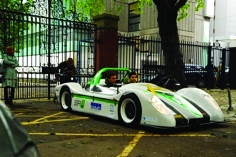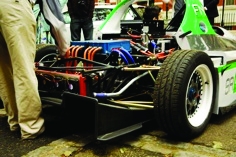The Pan-American Highway is famous for its extreme terrain. Travelling through 14 different countries, it snakes around freezing mountain passes and dry deserts, pushing the limits of even the most robust of vehicles.

As the longest road in the world, it certainly isn’t somewhere you would expect to see an electric car. But next month, graduates from Imperial College London intend to be the first to travel the 26,000km stretch in an electric vehicle (EV) when they unleash their repurposed Radical SR8 sports car on the highway.
The ambitious drive is part of a project known as Racing Green Endurance (RGE), which began in January last year. Since then, the 11-strong team has adapted the SR8 vehicle to make it roadworthy for the three-month journey from the north of Alaska to the world’s southernmost city, Ushuaia.
’It’ll be a tough trip and not just from a mechanics perspective,’ said Nikolaus Sauer, RGE’s chief mechanical engineer. ’But we’ve done a lot of planning and testing and gained massive support from all over the world… I think we’re about ready to take on the challenge.’
The SRZero car has an average running cost of one penny per mile and a range of 248 miles
The SR8 is the world’s fastest production car, holding the lap record for the 20.8km Nürburgring race track in Germany. The RGE team has remodelled it into an electric vehicle, named SRZero, by stripping out the original 2.6 V8 engine and replacing it with two rear AC synchronous axial flux motors.
https://www.youtube.com/watch?v=P5XdVmH8aic
Alexander Schuey, project manager, claims that this has been a key factor in the car’s improved performance. ’Almost all electric road cars at the moment are using a motor technology called radial flux,’ he said. ’We’re using axial flux motors, which are very new on the market and are a lot more efficient.’
Unlike conventional electric motors, where the flux flows radially through the rotor and stator, the flux in an axial motor flows parallel to its axle. This means that the motor can be made lighter and thinner, with a high specific torque that provides double the amount of power available for performance.

’The power and range on the SRZero is unlike any other EV,’ said Toby Schulz, chief systems engineer. ’We want to change the public view of electric cars. People normally associate them with milk floats and G-Wizs…That’s not where this technology is heading. We’ve taken the fastest production car in world to show that electric can be fast and exciting.’
With a peak power output estimated at more than 400hp, the SRZero has more in common with a Ferrari than a G-Wiz. The power is provided by lithium-iron phosphate battery cells with a total capacity of 56kW, while two controllers at the rear of the car change the DC output from the battery pack into an AC signal to drive the electric motors.

The group claims that the car has an average running cost of one penny per mile and a range of around 248 miles (399km). This compares to a driving range of 245 miles and a running cost of around 1.5p per mile for the Tesla Roadster. On the days of full driving, the batteries are expected to be drained two thirds, charged one third and then depleted ready for an overnight charge.
We want to get as many people involved along the way as we can. This is just as much about showcasing the technology as it is about completing the route…It’s going to be a pretty epic adventure and who knows what we’ll run into.Andy Hadland, RGE
Andy Hadland, RGE’s spokesperson, has been drumming up support from sponsors and the public in the run-up to the trip. ’We want to get as many people involved along the way as we can,’ he said. ’This is just as much about showcasing the technology as it is about completing the route…It’s going to be a pretty epic adventure and who knows what we’ll run into.’
The team has already gained a following on Twitter and Facebook, with people along the route offering accommodation and charging points when needed. However, technical problems are as much a concern on the route as finding charging points for the vehicle. The first of these was seen during the car’s initial drive when problems with electromagnetic interference (EMI) meant that it had to go back to the garage for several days.
’There was actually a moment where we charged the car up in a private house and suddenly phones start ringing, bells start ringing, and we were like what is going on?’ said Clemens Lorf, chief operations manager. ’We realised it was because of EMI and this is not an issue just for us; the industry is still working on a standard on EMI and we’re figuring out what everyone else is trying to understand out there the moment.’

EMI is one of the biggest problems for electric and hybrid vehicles. Each of the main components of the SRZero’s electric drive act as a path for electromagnetic emissions, with the power converter being the main source of EMI. High levels of EMI can lead to mixed signals being sent to other components in and around the vehicle, causing the electrical systems to behave erratically.
After the initial setback, the team solved the EMI problem by using a combination of shielded cable, a range of capacitors and some ferromagnetic ceramic rings to reduce the SRZero’s noise levels from EMI to acceptable levels. A week later, the group took the car on the M25 and set a record in becoming the first team to drive an EV around the London orbital twice on one battery charge.
https://www.youtube.com/watch?v=-MkZlb29ge8
The RGE team is now in the process of making final preparations for its Pan-American journey, which will be filmed by documentary producer Claudio Von Planta. The car and all the equipment are expected to be flown to Alaska at the end of this month, ready for the journey to begin on 8 July. But Prof Nigel Brandon, director of the Energy Futures Lab at Imperial College, believes that the successful completion of the journey will make more than just a documentary series. ’This is a fantastic project that’s not only inspiring to the next generation of engineers but also important for the UK’s engineering industry,’ he said.
’A lot of the components of this vehicle come from the UK and it’s a showcase of what British engineering can do,’ added Brandon. ’I think the UK is well placed to make a contribution here because we have world-class capability in developing the next generation of vehicles. So when it comes to some of the step-change technologies, we definitely have a role to play…It’s projects such as RGE that will help show exactly what it is we can achieve.’
Follow RGE on Twitter @RGEndurance
Students get up to speed

Racing Green Endurance was born in 2008 as a spin-off from Imperial Racing Green - an undergraduate teaching programme aimed at designing and manufacturing fuel-cell hybrid vehicles. The programme currently involves 100 students from eight departments within the university who, together, have entered several races across the globe.
The group is in the process of working towards its first full-size-battery electric track vehicle to enter into the IMechE’s 2011 Formula Student competition.
The team is also carrying out research into fuel cells and their application to race vehicles, with the hope of producing a fuel-cell-powered track vehicle for 2012.




Red Bull makes hydrogen fuel cell play with AVL
Formula 1 is an anachronistic anomaly where its only cutting edge is in engine development. The rules prohibit any real innovation and there would be...